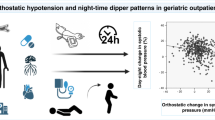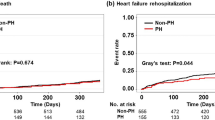Abstract
Orthostatic hypotension (OH) is a common finding in the elderly. OH is defined as a fall of at least 20 mmHg in systolic blood pressure (BP) and/or 10 mmHg in diastolic BP upon assuming an upright posture. Some patients exhibit a fall in BP of less than the defined OH upon standing. The aim of this study was to estimate the prevalence of BP changes not defined as OH among elderly in-patients and to assess the relationship between these changes in the morning and the occurrence of OH during the day. Postural BP measurements were performed in 502 in-patients; in the morning, early afternoon, and in the evening. We defined intermediate postural drop (ID) in BP as a decrease of 10–19 mmHg in systolic BP and/or of 5–9 mmHg in diastolic BP. We observed that OH and ID occurred in 39.2 and 18.5% of the measurements in the morning, respectively. The prevalence of OH and ID was lower in the evening than in the morning (P<0.05) and afternoon (P<0.005). Postural BP changes in the morning correlated with those occurring later in the day. Patients who had ID in the morning had a 57% probability of having OH later during the day. In conclusions, ID is prevalent in elderly in-patients. ID in the morning predicts OH later in the day. Thus, postural BP drops below the OH range may be an important finding in the geriatric population.
This is a preview of subscription content, access via your institution
Access options
Subscribe to this journal
Receive 12 digital issues and online access to articles
$119.00 per year
only $9.92 per issue
Buy this article
- Purchase on Springer Link
- Instant access to full article PDF
Prices may be subject to local taxes which are calculated during checkout


Similar content being viewed by others
References
Carlson JE . Assessment of orthostatic blood pressure: measurement technique and clinical applications. South Med J 1999; 92: 167–173.
Lipsitz LA . Orthostatic hypotension in the elderly. N Engl J Med 1989; 321: 952–957.
Mader SL . Aging and postural hypotension. An update. J Am Geriatr Soc 1989; 37: 129–137.
Consensus statement on the definition of orthostatic hypotension, pure autonomic failure, and multiple system atrophy. The Consensus Committee of the American Autonomic Society and the American Academy of Neurology. Neurology 1996; 46: 1470.
Mathias CJ . Orthostatic hypotension: causes, mechanisms, and influencing factors. Neurology 1995; 45: S6–S11.
Masaki KH et al. Orthostatic hypotension predicts mortality in elderly men: the Honolulu Heart Program. Circulation 1998; 98(21): 2290–2295.
Weiss A, Grossman E, Beloosesky Y, Grinblat J . Orthostatic hypotension in acute geriatric ward: is it a consistent finding? Arch Intern Med 2002; 162: 2369–2374.
Engstrom JW, Martin JB . Disorders of the autonomic nervous system. In: Brauwald E, Fauci AS, Kasper DL, Hauser SL, Longo DL, Jameson JL (eds). Harrison's Principles of Internal Medicine. 15th ed. McGraw-Hill: New York; 2001, pp 2416–2421.
Caird FI, Andrews GR, Kennedy RD . Effect of posture on blood pressure in the elderly. Br Heart J 1973; 35: 527–530.
Mader SL, Josephson KR, Rubenstein LZ . Low prevalence of postural hypotension among community-dwelling elderly. JAMA 1987; 258: 1511–1514.
Palmer KT . Studies into postural hypotension in elderly patients. N Z Med J 1983; 96: 43–45.
Mader SL, Palmer RM, Rubenstein LZ . Effect of timing and number of baseline blood pressure determinations on postural blood pressure response. J Am Geriatr Soc 1989; 37: 444–446.
Davis BR et al. The association of postural changes in systolic blood pressure and mortality in persons with hypertension: the Hypertension Detection and Follow-up Program experience. Circulation 1987; 75: 340–346.
Harris T, Lipsitz LA, Kleinman JC, Cornoni-Huntley J . Postural change in blood pressure associated with age and systolic blood pressure. The National Health and Nutrition Examination Survey II. J Gerontol 1991; 46: M159–M163.
Rutan GH et al. Orthostatic hypotension in older adults. The Cardiovascular Health Study. CHS Collaborative Research Group. Hypertension 1992; 19: 508–519.
Applegate WB et al. Prevalence of postural hypotension at baseline in the Systolic Hypertension in the Elderly Program (SHEP) cohort. J Am Geriatr Soc 1991; 39: 1057–1064.
Burke V et al. Postural fall in blood pressure in the elderly in relation to drug treatment and other lifestyle factors. Q J Med 1992; 84: 583–591.
Raiha I et al. Prevalence, predisposing factors, and prognostic importance of postural hypotension. Arch Intern Med 1995; 155: 930–935.
Tilvis RS, Hakala SM, Valvanne J, Erkinjuntti T . Postural hypotension and dizziness in a general aged population: a four-year follow-up of the Helsinki Aging Study. J Am Geriatr Soc 1996; 44: 809–814.
Ooi WL, Hossain M, Lipsitz LA . The association between orthostatic hypotension and recurrent falls in nursing home residents. Am J Med 2000; 108: 106–111.
Davis BR et al. The association of postural changes in systolic blood pressure and mortality in persons with hypertension: the Hypertension Detection and Follow-up Program experience. Circulation 1987; 75(2): 340–346.
Miller RA . The biology of aging and longevity. In: Hazzard WR, Blass JP, Ettinger WH, Halter JB, Ouslander JG (eds). Principles of Geriatric Medicine and Gerontology, 4th ed. McGraw-Hill: New York; 1999, pp 3–19.
Atkins D, Hanusa B, Sefcik T, Kapoor W . Syncope and orthostatic hypotension. Am J Med 1991; 91(2): 179–185.
Chobanian AV et al. National Heart, Lung, and Blood Institute Joint National Committee on Prevention, Detection, Evaluation and Treatment of High Blood Pressure; National High Blood Pressure Education Program Coordinating Committee. The Seventh Report of the Joint National Committee on prevention, detection, evaluation and treatment of high blood pressure the JNC 7 report. JAMA 2003; 289(19): 2573–2575.
Acknowledgements
We thank Mrs Alexandra Yalov for the statistical analysis, Mrs Ruthy Miller, Mrs Gloria Ginzach and Mrs Doris Naor, for their helpful assistance in editing the manuscript and to Dr H Weiss, for her critical review of the paper.
Author information
Authors and Affiliations
Corresponding author
Rights and permissions
About this article
Cite this article
Weiss, A., Chagnac, A., Beloosesky, Y. et al. Orthostatic hypotension in the elderly: are the diagnostic criteria adequate?. J Hum Hypertens 18, 301–305 (2004). https://doi.org/10.1038/sj.jhh.1001668
Received:
Revised:
Accepted:
Published:
Issue Date:
DOI: https://doi.org/10.1038/sj.jhh.1001668
Keywords
This article is cited by
-
An anthropogenic model of cardiovascular system adaptation to the Earth’s gravity as the conceptual basis of pathological anthropology
Journal of Physiological Anthropology (2021)
-
Reliability of orthostatic beat-to-beat blood pressure tests: implications for population and clinical studies
Clinical Autonomic Research (2017)
-
Are small observational studies sufficient evidence for a recommendation of head-up sleeping in all patients with debilitating orthostatic hypotension? MacLean and Allen revisited after 70 years
Clinical Autonomic Research (2009)



